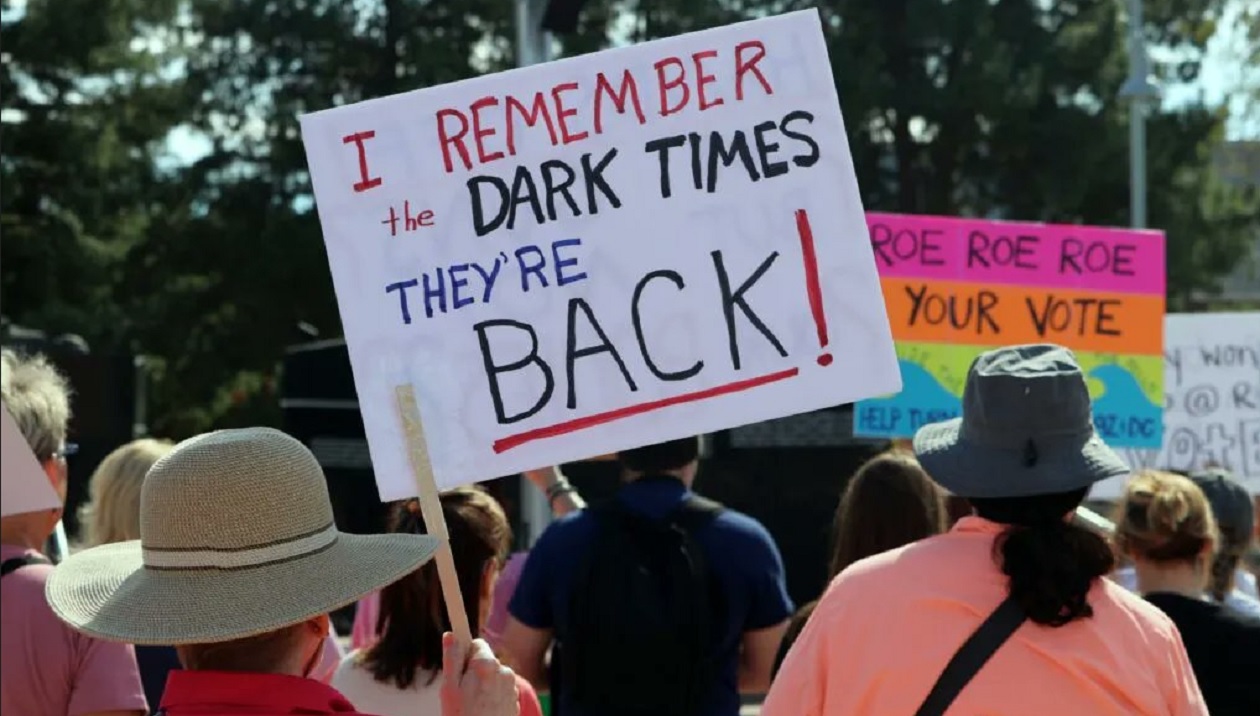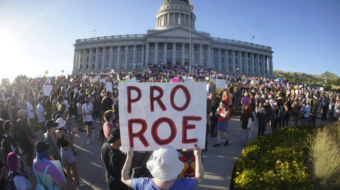
WASHINGTON—Make no mistake: The hundreds of thousands of marchers in more than 1,000 “Women’s Wave” rallies, demonstrations, and teach-ins from coast to coast had one specific target on October 8: Defending the right to abortion by defeating, next month, the right-wingers who destroy it.
In protests from Anchorage and Los Angeles to Boston, Washington, New York, Chicago, and Miami, women’s rights advocates—female, male and other—made their voices and their views heard loud and clear, with four weeks to go before the November 8 balloting.
Summarizing the crowds’ views of the right-wingers and their campaign to ban abortion nationally, one handwritten D.C. sign read: “Unless it is your body, shut up!”
“Roe, Roe. Roe your vote!” was one of the milder signs at one of the largest of the rallies, in D.C., referring to the 1973 Roe v Wade Supreme Court ruling that abortion is a constitutional right—a right the current court’s Republican five-Justice majority revoked at the end of June.
The majority’s decision, and Republican senators’ and presidents’ role in constructing it, set off a furor and upended the nation’s electoral arithmetic for the coming mid-term voting—and the anger hasn’t abated since, either among speakers or the rank-and-file interviewed.
The D.C. march drew more than 10,000 people parading from a park southeast of the Capitol to its reflecting pool on the west—though not to the Supreme Court. Before its ruling, the court majority ordered high black fences erected around the court building, too.
A smaller group of anti-abortionists tried to disrupt the D.C. march, but police and barricades kept them apart from the big march.
“The majority is mad,” said one of three SEIU 1199 members, all Black women, relaxing while waiting to board their bus back to the Cleveland area. “The bottom line is the decision is between you and God,” said the second.
“I’m pissed off. My mother has more rights than my daughter has,” said Kim Brown, a Floridian who flew to D.C. with her spouse, Victor Starr, from Frankfurt, Germany.
“Hell hath no fury like a woman who’s lost her right to choose,” read a sign. “Never underestimate the power of 1000s of extremely pissed-off women,” said another. A third featured a photo of the U.S. Capitol and, handprinted next to it, the words: “This is not a church,” with an arrow pointing at it. “Abort SCOTUS,” some printed signs read in reply to the justices.

“We won’t go back!” was a frequent chant. And, given large contingents of unionists, especially from SEIU (Service Employees) 1199, which sent buses from the Northeast and Midwest, “Show us what democracy looks like! This is what democracy looks like!”
“I’m fired up and ready to do for the next four weeks. We know what we have to do,” declared Rachel Carmona, executive director of the Women’s March, which organized the latest cavalcade of protests from coast to coast.
“We have to spend half our time marching and half our time on getting out the vote to make sure this election is a women’s wave. It’s life or death,” she added, pausing for emphasis. “It really is that.
“This election is a clear choice between Americans who work for a living and take care of their families and the Trump Republicans who just want to take away our freedoms. Our rights and our freedoms are on the ballot.
“In a rigged system, rigged by Trump Republicans, they want to divide us and take away” rights “especially from Black and brown Americans” and other minorities, she said.
She also had a warning for the Democrats, who profess support for the constitutional right to abortion: The marchers would hold them to that pledge and others, including passing the Equal Rights Amendment. Or the Dems, too, would get tossed out, said Carmona.
Besides the D.C. protest, thousands more marched in Chicago, New York, Los Angeles, Seattle, Anchorage, Honolulu and so many cities in Texas that the marchers’ online map of the state was covered in blue dots.
Some speakers, and some signs, linked the battle for abortion rights to other struggles, including the current mass protests in Iran over the religious police’s murder of a 22-year-old woman for wearing her hijab too low, Black Lives Matter, and campaigns for immigrant rights and worker rights.
“It is personal to have our bodies suppressed,” Fatima Goss Graves, executive director of the National Women’s Law Center, told the D.C . crowd. “It is personal to have our votes suppressed. It is personal to have our labor ignored. It is personal to fear for our children’s future. I want to be clear: This is a generational fight.”
The pro-abortion forces have celebrated some victories since the High Court’s five-Republican majority tossed the national constitutional right at the end of June. Barely six weeks later, given the chance to oust the right to abortion from their own state constitution, 58% of voters in a referendum in deep-red Kansas said “no.”
In a swing seat congressional district in New York’s Upper Hudson Valley, the Democratic nominee, tech businessman Pat Ryan, latched onto the abortion issue after the High Court’s ruling and eked out a special election win over a more-well-known Republican—and abortion foe—Marcus Molinaro.
And despite opposition from their legislature’s dominant Republicans, Michigan voters will have a chance in a month to write abortion rights into their constitution, too.
“Yesterday, the courts gave us a 30-day stay” on Ohio’s draconian “abortion ban,” D.C. marcher Gwen Longbotham of Worthington, said. “That’s exciting.” She opted for the D.C. march over one in the nearby state capital of Columbus.
They’re also getting political help, she added, from Rep. Tim Ryan (D), who seeks an open Republican-held seat in the evenly split U.S. Senate. Polls show Ryan with a slight lead, within the margin of error, against Republican abortion foe J.D. Vance, an election denier and far-right-winger better known as a writer. “Tim’s doing a lot to get people going,” said Longbotham.
That’s a pattern nationwide, something speakers in D.C. and elsewhere emphasized. Starting in July, statistics show an enormous jump in newly registered voters. The overwhelming majority of them are women, angered by the High Court’s ruling.

That’s transferred to the campaign trail, and the marchers intend it should stay that way. Indeed, the 11 am Pacific time march in Los Angeles was followed by a day-long seminar on canvassing, mobilizing, organizing, and ensuring abortion rights backers vote.
But not everybody is on board, especially outside cities.
“My area is very rural, so you’re hearing a lot about Trump and a lot about guns,” said Betsy Clark of Delaware County, N.Y. Trump named three of the Supreme Court Republicans who eliminated the constitutional right to abortion—and the gun culture is big in rural areas of the Empire State. Earlier, the court majority had tossed out New York’s gun restrictions, too.
“There’s a vast difference, depending on who you talk to,” mused SEIU 1199 member Brian Clark of Euclid, Ohio. “There are a lot of people who are very upset” by the court’s ruling “and a lot of people who are animated” by it. “My circle isn’t necessarily going to be representative, because I am somebody who thinks the Supreme Court decision was egregious.”
“We’re mighty fortunate, but that could change in a second. So we’re here to share rights and to fight for others,” said Lyndsey Nunes, a Massachusetts State Employees Association/SEIU member from Springfield. Republicans in Congress, notably Sen. Lindsey Graham, R-S.C., seek to write a federal law banning all abortions in all circumstances.
And Rebecca McInnis of Coeburn, Va., in the state’s “Southside” area, described how she has to try to educate her neighbors on the issue—and its implications.
“We have a frightening situation in our country,” she mused. “I don’t want us to become like Iran,” a theocracy. “But when I tell people ‘We’re doing a march,’ they go: ‘What? What is that about?’” And to ensure control, authorities in her area have taken away polling places, too, she said.
At least one sign declared the threat is not just to the constitutional right to abortion, but to much more.
“Bodily autonomy is a fundamental right,” it read. “If you don’t have control over that, you don’t have any rights. And a threat to any rights is a threat to everybody’s rights.”










